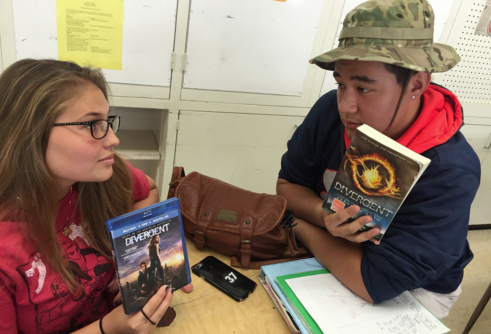Radford Divided Between Books and Movies

Keely Beck (12) and Alex Gibson (11) debate on the issue of books and movies. Many see movies as a better representation of a story, while others prefer to create their own story with books. “I’d rather watch the movie, it’s more interesting,” Beck said. (Photo by Adaliah Collins)
February 19, 2016
Bookworms and movie lovers alike have debated over the same issue since the beginning of time. Which best represents a story, films or books?
It has become an ever growing trend to transform beloved paperbacks into movies, and while some enjoy seeing them on the big screen, others see this as an inaccurate and unfulfilling representation of the characters and storyline.
It’s no surprise that books contain more details than the movies. Books aren’t restricted to the two-three hour time that limits films, but allows for more plotline. It also gives authors freedom to to review character background and details. Movies, on the other hand, are rarely able to live up to these intricate storylines, and end up sacrificing details that can explain main messages behind the book. With this, books are able to fill a void that films simply just can’t do.
“Movies need to keep in mind that the audience wants something exciting to watch, so a lot of the fluff and details of the actual book aren’t going to make the cut. But at the same time, they need to be mindful about some of the small details that make the book what it is,” Michael Montoya (11) said.
An important set of details that many movies fail to acknowledge is character appearance. While this issue seldom affects the outcome of plot, readers create a connection to characters based on their physical appearance.
In The Mortal Instruments: City of Bones, we meet the flamed-hair Clary, known for her bright orange locks. The movie, however, takes a different turn with a more maroon shade. Another film, Percy Jackson & the Olympians: The Lightning Thief, changes character Annabeth’s hair from curly blonde to sleek brown. This change in character appearance can break some of the connections that readers create with a novel’s imagery. It can make the movie appear less familiar for book readers.
Another pressure that film producers are tasked with handling is expectation. The task of transforming a well loved book into a representation that can satisfy the book’s audience can be demanding and complex.
Cristian Torres (11), who prefers books said, “Books allow you to create the characters and the world to your own perspective. Whereas with a movie, you’re locked into the perspective as to how the director viewed the book even if their perspective was wrong.”
One epic flaw film producers make is leaving out events and characters, or changing them. Many popular and classic books are changed when producers sit down and write the script.
In the 1908 classic, The Count of Monte Cristo, Edmond Dantes seeked vengeance on his enemies with careful and patient planning. In the film, Edmond is impatient and cunning, and seeks revenge on his enemies by acting in violence.
Another book that changed scenes is Gillian Flynn’s Gone Girl. Flynn’s hit novel included unique characters that producers cut out of the film entirely. With some important scenes missing, it is crucial when explaining the character’s personality. It changed the perspective of a few characters. Unnecessary changes such as these can take away from what the book really is if not done properly, and make it confusing for those who have not read the book.
Even with all of these disadvantages of transferring a story from pages to the big screen, there are benefits.
Books can be known to have a hit or miss chance at popularity. When some books fail to meet reader expectation, whether in a series or on their own, producers can choose to make the plotline better by altering the story. In many films, the book can be almost unrecognizable to the audience, but this can actually be a good thing.
“I don’t read as much as I want to, but when I do, I prefer books over movies based on books,” Emma Winters (12) said. “My favorite book is ‘The Outsiders.’ It was the first book I fell in love with, and they turned it into a movie. It wasn’t as bad as I thought it would be, but I was excited about it either way because it was my favorite book.”
Bookworms know well that they will not always be satisfied with a book’s ending. If the book falls in the hands of the right producers, they can alter the ending to keep the audience entertained.
Frank Darabont, the director and screenwriter of Stephen King’s, “The Mist,” was able to change the ending without causing uproar. In King’s ending, it was very uplifting, which took away from the eerie feeling throughout the novel. With Darabont’s changes, he was able to keep that darkness that King is so well known for.
Sometimes even casting the right person for a role can make a movie shine. Boaty Boatwright, who was in charge of casting of “To Kill A Mockingbird,” was able to bring Harper Lee’s best-selling book to life by casting Gregory Peck to play the noble Atticus Finch. Peck’s spot on performance gave Atticus’s character more depth than portrayed in the book and made it possible for the movie to live up to the expectations of the novel. But even though making a movie superior to the book, it is rarely seen in the film industry.
Overall, the success of transforming a book into a movie really depends on character portrayal and plotline precision. A reader takes many expectations into the theatre, and these can be let down if a producer fails to offer similar imagery to the reader’s imagination.
With many producers not taking these small things into consideration, books will forever be victorious.

